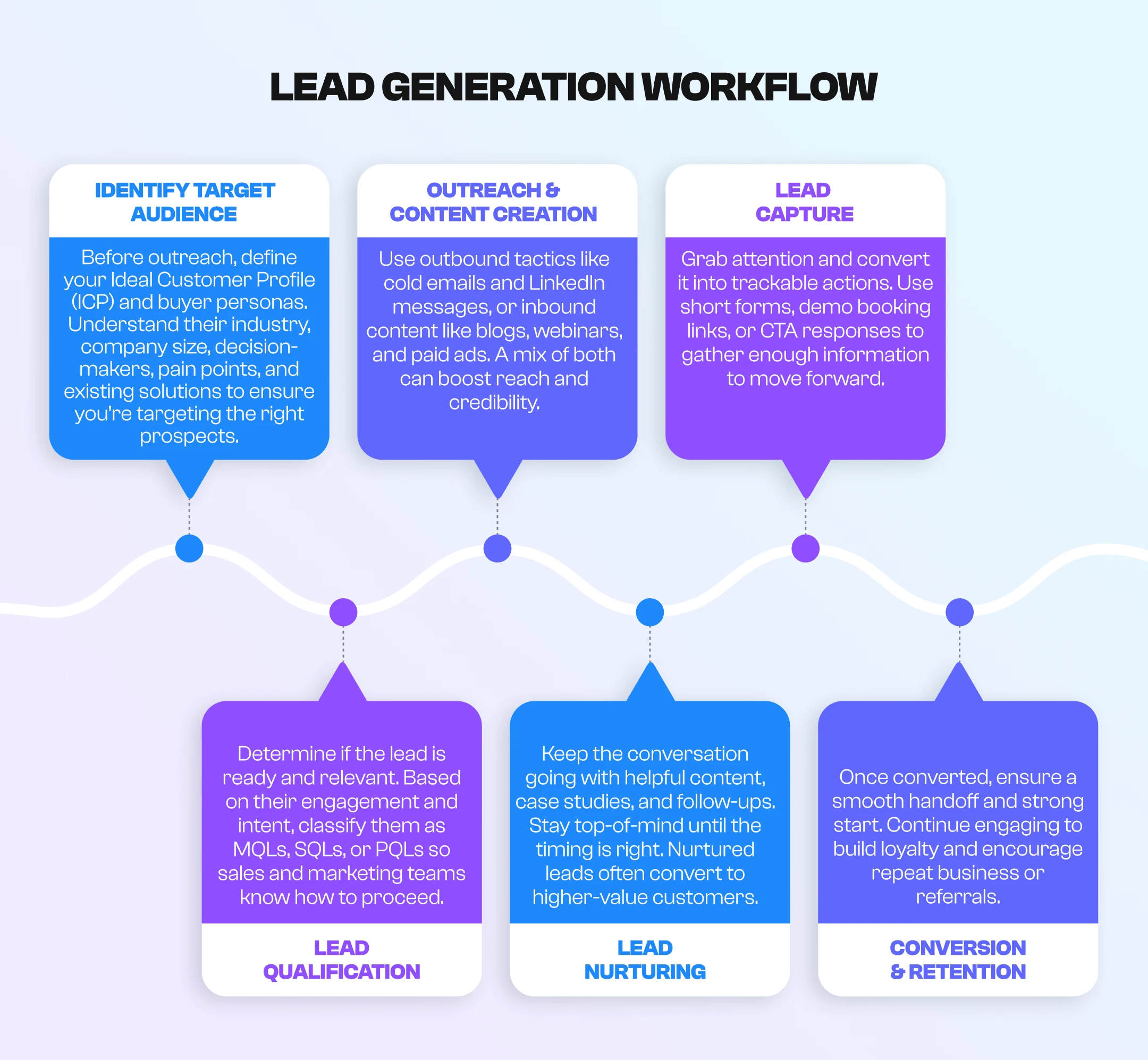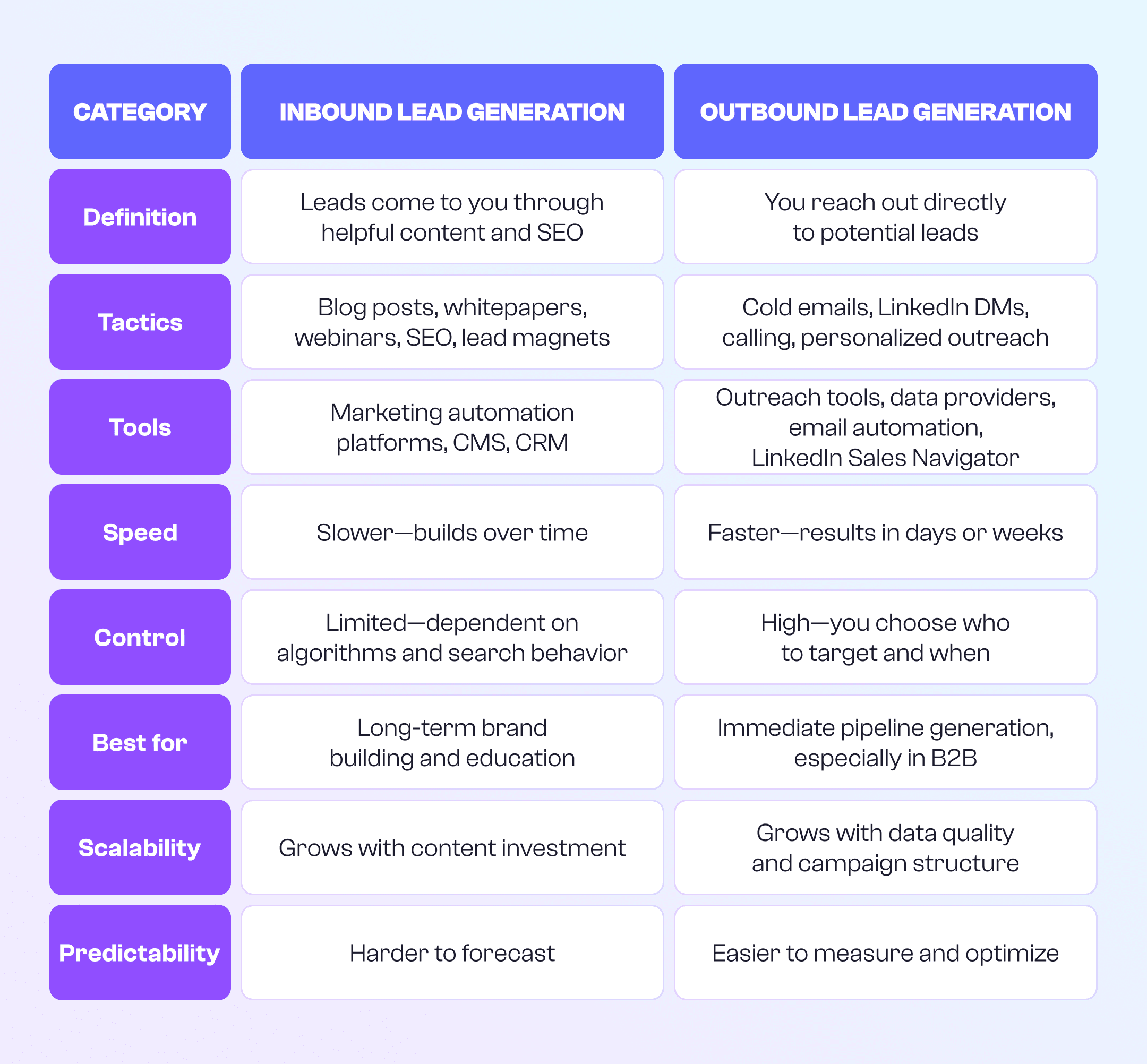Let’s get straight to it—lead generation is how businesses get potential customers interested in what they’re offering. That’s it. No fluff. It’s the process of turning strangers into potential customers. You need leads to grow, whether selling software, financial services, or eco-friendly office furniture.
So, what does generating leads mean in practice? It means getting in front of the right people and giving them a reason to say, “Tell me more.” And for sales teams, especially in B2B, it’s the heartbeat of everything they do. No leads? No pipeline. No pipeline? No sales.
In this article, we’ll break it all down—what is inbound lead generation, the difference between inbound and outbound, how to run smart campaigns, and what a solid outreach strategy looks like. You’ll also see why dozens of clients trust SalesAR to bring results with our outbound-focused approach.
What Does Generating Leads Mean in B2B?
B2B lead generation is about initiating conversations with decision-makers at other companies—people with the budget, the need, and the authority to approve. Unlike B2C (business-to-consumer), where you might impulse-convince someone to buy a phone case or a subscription box, B2B deals are longer, more complex, and involve multiple stakeholders. That means every lead needs to be qualified, relevant, and well-timed.
So, what is B2B lead generation in practice? It identifies businesses that could benefit from your product or service and sparks interest through targeted outreach. This often involves outreach campaigns via email, LinkedIn, or even calls, especially when the sales cycle involves high-value contracts or enterprise-level decisions.
Now, how’s that different from B2C? For starters:
- B2B focuses on logic and ROI, while B2C leans more into emotions and quick wins.
- B2B involves multiple touchpoints and longer cycles, whereas B2C is often one-click purchases.
- B2B buyers conduct research, compare vendors, and need to justify costs to their superiors.
Let’s bring this to life with a real example. At SalesAR, we have worked with multiple SaaS and tech firms that needed to break into new markets but lacked the in-house resources to scale outbound outreach. One client in the AI-powered analytics space went from cold starts to booking over 297 meetings through targeted outbound campaigns we managed for them. You can check out more stories like that in our case studies.
If you’re curious to learn more about how this all works, our article “What is a lead generation strategy” provides a complete breakdown.
B2B lead generation is more than just collecting emails—it’s about building a system that consistently brings the right leads to your sales team. When done well, it doesn’t just fill the top of your funnel—it drives real business growth.
What Is the Lead Generation Process?

If you’ve ever asked, “What is the lead generation process?”—this is it, laid out step by step. Whether you’re running outbound outreach or inbound content, the same structure applies. You’re not just chasing emails; you’re building a system that turns strangers into customers.
Let’s go deeper into each part of the process.
1. Identifying Your Target Audience
Before you write a single message or design a landing page, you need to know who you’re talking to. That means defining your Ideal Customer Profile (ICP) and key buyer personas.
Ask yourself:
- What industry are they in?
- What size is the company?
- Who makes the buying decisions (job titles)?
- What problems are they trying to solve?
- What tech stack or solutions are they currently using?
This stage sets the tone for everything that follows. If you miss the mark here, you’ll spend time and money speaking to the wrong crowd. At SalesAR, we dig deep with every client to build a laser-targeted audience list. It’s one of the main reasons our outreach campaigns get results.
2. Outreach or Content Creation
Once you know who your audience is, it’s time to grab their attention. This can go in two directions:
Outbound – You reach out to potential leads directly via:
- Cold emails
- LinkedIn messages
- Personalized video messages
- Phone calls (less common in tech, but still effective in some verticals)
Inbound – You create content that draws leads to you:
- SEO-optimized blog posts
- Lead magnets (like ebooks or whitepapers)
- Free tools or webinars
- Paid ads directing to a landing page
A solid lead generation campaign often blends both approaches. For example, one of our SaaS clients used outbound email to spark interest, then linked leads to a content hub that reinforced credibility.
3. Lead Capture
Getting attention is one thing. Getting a response is another.
Lead capture is where the interaction becomes trackable. You must create a clear, easy way for the lead to express interest. That might include:
- A short form on a landing page
- A calendar link to book a demo
- A CTA in a LinkedIn message
- A response to your cold email
Keep it simple. The more fields or steps involved, the more people drop off. A good rule is to capture enough information to qualify the lead rather than collecting every detail upfront.
4. Lead Qualification
Now that you’ve got someone’s interest, the next step is determining if they’re worth pursuing. Not every lead is ready to buy—or even a fit. That’s why qualification matters.
Here’s how the different lead types break down:
- MQL (Marketing Qualified Lead): They’ve engaged with your campaign but aren’t ready to talk to sales yet. Maybe they downloaded a guide or clicked a CTA.
- SQL (Sales Qualified Lead): They have shown clear intent—perhaps they requested a demo or replied to your email with a meeting request.
- PQL (Product Qualified Lead): In product-led models, these are users who’ve tried your platform (like during a free trial) and are active or hitting usage milestones.
This step helps your team prioritize and route leads properly. Sales can focus on ready buyers, and marketing can continue nurturing the rest.
5. Lead Nurturing
Most B2B leads aren’t going to convert the second they hear from you. Maybe the timing is off. Perhaps they’re still evaluating competitors. Maybe they need to convince their boss.
Nurturing bridges that gap. It’s all about keeping the conversation alive:
- Drip emails with helpful tips
- Case studies that show real results
- Re-engagement messages
- Invitations to events or webinars
The goal isn’t to push—it’s to stay visible and valuable until the lead is ready. And that timing matters: nurtured leads make 47% larger purchases than non-nurtured ones.
6. Conversion
Here’s where everything comes together. The lead takes the next step—booking a meeting, signing a contract, and becoming a customer.
But even here, the job isn’t done. A clean handoff from sales development to account execs (or from marketing to sales) makes a big difference in win rates. Maintain the momentum, deliver on your promises in your outreach, and establish a strong relationship from the outset.
At SalesAR, we measure success by the number of meetings booked and the number of closed deals. That’s the real ROI of a well-executed lead generation campaign.
The whole lead generation process isn’t complicated—it just requires focus and consistency.
If you’re running a campaign and not seeing the results you expect, one of these steps needs improvement. Fix the weak link, and the whole chain performs better.
Would you like to see this kind of system applied to your business? SalesAR’s outreach campaigns are built to follow this exact structure, and we’re happy to show you how it looks in practice.
Book a quick call to explore tailored pricing options based on your goals, industry, and budget — and see how high-quality B2B leads can drive real results.
What Is a Lead Generation Campaign?
You’ve heard the term thrown around—lead generation campaign—but what qualifies as one?
A lead generation campaign is a structured effort to attract and convert potential customers using a combination of channels, content, and outreach tactics. It’s not just sending a few cold emails or running a single ad. A campaign has a start, a strategy, and a set of goals—usually focused on filling your pipeline with qualified leads.
Whether you’re targeting enterprise IT buyers or marketing execs at SaaS startups, a well-executed campaign is how you consistently get meetings on the calendar.
Tools and Tactics That Drive Results
The tactics you use depend on your goals and target audience. Here are the components of a high-performing lead generation campaign:
- Email sequences: Cold emails, follow-ups, reactivation messages—all crafted for specific personas
- LinkedIn outreach: Personalized connection requests, DMs, and content engagement
- Landing pages: Custom-built to match your offer and collect contact info
- Lead magnets: Downloadables, free tools, case studies—something valuable to exchange for an email
- Calendars and meeting schedulers: Make it easy for prospects to book time
These tools aren’t used in isolation. The power is in combining them into a cohesive, multi-touch experience.
How SalesAR Builds Smart Campaigns
At SalesAR, we specialize in outbound campaigns—encompassing cold emails, LinkedIn, and more—but the magic lies in how we personalize and sequence everything.
Here’s what that process looks like:
- Audience research: We build or enrich high-quality prospect lists based on your ICP
- Custom messaging: Each persona gets its message flow—no one-size-fits-all templates
- Multi-channel outreach: Prospects are engaged across email and LinkedIn, sometimes even phone
- Follow-up automation: Timed sequences keep you top of mind without becoming spam
- Real-time reporting: You get complete visibility into results, replies, and meetings booked
It’s not just about volume—it’s about relevance. One well-personalized message will always beat a blast to 5,000 people.
Campaign KPIs That Matter
Not all metrics are created equal. When measuring campaign performance, focus on KPIs that reflect real progress:
- Meetings booked: The gold standard—did the campaign get sales calls on the calendar?
- Reply rate: Shows how well your messaging is resonating
- Open rate: A good signal of subject line performance (but not the end goal)
- Positive response rate: Of all replies, how many were interested?
- Lead-to-opportunity ratio: How many leads are turning into real deals?
Are you looking to run one yourself? Here’s a step-by-step breakdown on how to generate leads for businesses.
A successful lead generation campaign isn’t just about getting names—it’s about building a repeatable engine for growth. And once that engine is running, your sales team can finally focus on what they do best: closing.
Inbound vs. Outbound Lead Generation
When people discuss “what is lead generation in sales”, they often categorize it into two primary categories: inbound and outbound. Both aim to generate leads, but how they do it and how quickly they achieve results differ significantly.
What is inbound lead generation?
Inbound lead generation is about attracting potential customers to your business by offering valuable content and resources. This could include blog posts, SEO, webinars, or free tools—anything that helps your audience find you naturally when searching for answers. Instead of reaching out directly, you draw people in by being helpful and visible.
What is outbound lead generation?
Outbound lead generation takes a more direct approach. You actively reach out to potential leads through cold emails, LinkedIn messages, calls, or even ads. The goal is to reach the right people with a clear message and a compelling call to action. It’s especially effective in B2B when you need quick, targeted pipeline growth.
If you’re in B2B and need leads, outbound usually wins in speed, control, and targeting. Let’s break it down with a side-by-side comparison.

Why Outbound Wins in B2B (and Why SalesAR Leans Into It)
Let’s say you’re a SaaS company looking to book sales calls with enterprise clients. You don’t want to wait six months for SEO to kick in. You want meetings on your calendar this quarter. That’s where outbound takes the lead.
At SalesAR, our outbound campaigns consistently drive results like:
- 297+ meetings booked for an AI-driven analytics platform
- 7% reply rate on multi-step cold email sequences for a B2B fintech client
- 55,000+ verified contacts researched for a long-term SaaS engagement
- 4+ years of ongoing partnership with several clients who rely solely on our outbound system to generate pipeline
And unlike passive inbound strategies, we actively put your message in front of the exact people who matter—no waiting, no guesswork.
What Is Demand Generation vs Lead Generation?
Here’s a question that comes up often: What is demand generation vs. lead generation, and are they the same thing?
Not quite.
While they work together, they serve different goals in the marketing funnel. Think of demand generation as casting a wide net to build awareness and educate your market. Lead generation, on the other hand, focuses on converting that interest into actual contacts and sales conversations.
Demand Gen Builds Awareness, Lead Gen Drives Action
Here’s a simple breakdown:
- Demand Generation = Building interest
You’re creating content, sharing insights, speaking at events, running ads—anything that gets people to notice and trust your brand. But you’re not asking them to fill out a form yet.
- Lead Generation = Capturing interest
Now that they know you, it’s time to convert that attention into action: a meeting, a demo, a download, or a direct reply.
Both are part of the same journey, but their intent and timing differ.
At SalesAR, we’re known for our outbound lead generation campaigns, but many don’t see how we support demand creation, especially for newer companies or those entering a new market.
Here’s how we help on both fronts:
- Demand Gen: We position messaging to highlight unique value, build awareness in untouched segments, and spark curiosity—even before the first reply.
- Lead Gen: Then we turn that interest into a real pipeline with personalized outreach, multi-touch sequences, and strategic follow-ups that match the buyer’s stage.
For example, one tech client launched into a brand-new vertical. We used cold email to introduce the concept and educate, then followed up with targeted nurturing emails and case studies to push warm leads toward meetings. The result? Dozens of sales-qualified calls, even in an unfamiliar market.
Who Offers the Best Lead Generation Services?
When it comes to lead generation, many names are out there, and not all bring the same value. Some focus on quantity, others on automation, and a few specialize in tailored, human-led campaigns. Here’s a quick look at some of the notable players in the industry, each with their style and strengths.
Well-Known Industry Players
- Belkins – Known for appointment-setting and email deliverability consulting, Belkins works across multiple industries with a strong outbound focus.
- CIENCE – Offers a mix of human outreach and AI-powered services, often appealing to mid-market and enterprise-level companies looking for scalable campaigns.
- Martal Group specializes in outbound lead generation for tech firms, and its team of US and Canadian sales experts manages campaigns.
- Callbox – Blends inbound and outbound with phone-based outreach, often focused on APAC markets and multi-channel campaigns.
- UpLead and Apollo.io are not agencies but widely used tools for building B2B prospect lists and automating parts of outreach, which many agencies use as a foundation for their campaigns.
Each company offers something slightly different—some sell data, others do full-cycle campaigns. However, one name consistently stands out if you’re seeking personalized outbound lead generation with a dedicated team behind it.
Why SalesAR Stays Ahead
With 5+ years of proven experience, SalesAR delivers more than just lead lists—we bring strategic expertise that drives real results.
- 50,000+ leads generated for our clients.
- 100+ verified reviews from verified B2B clients on Clutch.
- 7%+ reply rate in key email campaigns.
- Clients partner with us long-term because we focus on personalized messaging, intent-driven outreach, and a multi-touch strategy built to convert.
From crafting personalized messaging to building a multi-touch outreach system, our goal is straightforward: to secure meetings that generate revenue.
Curious how it works?
When you’re ready to go beyond surface-level leads and build a pipeline that performs, SalesAR delivers.
Schedule a free strategy call to see how we deliver qualified B2B meetings — tailored to your goals, audience, and budget.
Final Thoughts: Why You Need Lead Generation Now
If your sales team waits for leads, you’re already behind. In B2B, where buying cycles are long and competition is fierce, sustainable growth starts with proactive lead generation. Not next quarter—now.
A steady flow of qualified leads doesn’t just fill your CRM; it also drives revenue growth. It gives your team something priceless: momentum. And when that momentum is backed by innovative outreach, clean data, and messages that resonate? That’s when sales start scaling.
Whether you’re entering a new market, launching a product, or just tired of unpredictable pipelines, lead generation is the lever that moves things forward. But it’s only effective if it’s done right.
FAQ
What is the lead generation?
In simple terms, lead generation is attracting people’s interest in what you sell. Whether through blog content, email campaigns, ads, or social outreach, the goal is to turn strangers into potential customers you can follow up with.
What is lead generation software?
Lead generation software enables businesses to automate the identification and capture of leads. These tools can encompass various functionalities, including data scraping platforms, CRM integrations, form builders, landing page creators, and email outreach systems. The most popular examples include HubSpot, ZoomInfo, Apollo.io, and Lemlist. At SalesAR, we utilize several tools internally, but always combine them with a human-driven strategy to achieve results.
What is a lead generation strategy?
A lead generation strategy is the game plan behind attracting, engaging, and converting potential customers. It includes defining your audience, selecting outreach methods (such as cold email or content marketing), crafting messaging, and establishing follow-up sequences. A good strategy aligns with your sales goals and evolves as you learn what works best.
What are lead generation companies?
Lead generation companies specialize in helping other businesses identify and connect with qualified prospects. They offer outbound outreach, appointment setting, contact research, and campaign management. Some, like SalesAR, focus on high-quality outbound B2B lead generation, while others might sell bulk data or offer inbound marketing support.
What is lead generation services?
Lead generation services are professional offerings where an agency or provider handles the entire process of identifying leads, reaching out to them, and setting up sales meetings. These services can include list building, messaging creation, automation setup, and campaign optimization. It’s essentially outsourcing your top-of-funnel growth to experts.
What is lead generation tools?
Lead generation tools help streamline the process of attracting and managing leads. They can include:
- Email automation tools (like Instantly or Mailshake)
- Prospecting databases (like LinkedIn Sales Navigator or UpLead)
- CRM systems (like Salesforce or HubSpot)
- Landing page builders and form tools (like Unbounce or Typeform)
Tools are essential, but without the right strategy behind them, they won’t convert.
What is a good lead generation conversion rate?
There’s no one-size-fits-all answer, but here’s a benchmark:
- A 2–5% conversion rate on outbound email (from sends to replies) is solid.
- A reply rate of 5–10% or higher is considered high-performing.
- You’re doing well if you’re booking meetings with 5–7% of all contacted leads.
No cold outreach, no stress. Just sales-ready calls with decision-makers.


